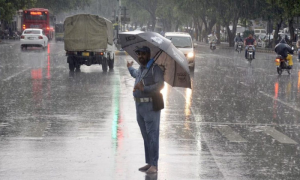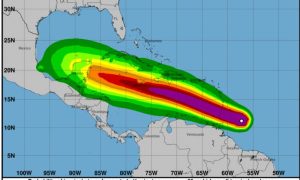BEIJING: Northern China experienced an intense cold spell in December, with snow, blizzards, and plummeting temperatures prompting authorities in the capital to suspend train services, close schools, and advise residents to stay indoors.
Beijing welcomed a cold air mass from the west, marking the second cold wave this week. City officials have raised the blizzard alert to the second-highest level, extending through Thursday—a unique warning in the country so far.
“When enjoying the snow, you also need to pay attention to keeping warm and ensuring safe travel,” Beijing’s observatory said, as snow fell in the city for the second time since Monday.
In anticipation of an extended period of snowfall that posed a threat of chaos, the city, home to nearly 22 million residents, took preventive measures by closing all schools and transitioning classes to online platforms starting Wednesday.
To adapt to the situation, businesses were instructed to provide their employees with flexible work arrangements and staggered commuting schedules. Moreover, in preparation for the severe weather conditions, scenic locations in the mountainous regions of the north and west were temporarily closed.
The impact extended to railway services, with suspensions affecting routes connecting key cities like Shanghai, Hangzhou, and Wuhan. Trains that remained operational ran at reduced speeds, resulting in significant delays. Despite this, Beijing’s Capital Airport remained open for operations.
This weekend, Beijing might experience temperatures plunging as low as minus 18 degrees Celsius (minus 0.4 degrees Fahrenheit), a stark contrast to its mid-December average of about minus 8 C (17.6°F). Even Shanghai, currently basking in a pleasant 20 degrees Celsius (68°F), is expected to endure a wintry chill of around minus 4 C (24.8°F) on Saturday and Sunday.
To brace for the impending cold, more than 6,000 rescuers have been placed on standby for road emergencies, alongside over 5,800 sets of snow-removal equipment. Approximately 32,000 metric tons of snow-thawing agents are prepared for use on icy roads and motorways.
City officials have mobilized volunteers to clear snow and ice, adding to the 73,000 people already assigned to these tasks, and have ordered an increase in indoor heating.
The last time Beijing encountered such extreme cold was on Jan. 7, 2021, when temperatures plummeted to minus 19.6 C (-3.28°F). The city’s all-time low of minus 27.4 C (-17.32°F) was recorded on Feb. 22, 1966.
This abrupt shift to colder weather, following the autumn-like conditions of the previous week, highlights recent drastic temperature fluctuations. October stood out as one of Beijing’s warmest months in decades amidst a year marked by weather extremes.
While northern China contends with temperatures below average, Hangzhou is set to officially commence winter on Dec. 16, a delay of two weeks from the usual schedule and the latest entry into winter since records began in 1951. Hangzhou, situated near Shanghai, had to register five consecutive days of temperatures below 10 degrees Celsius to declare the onset of winter.























